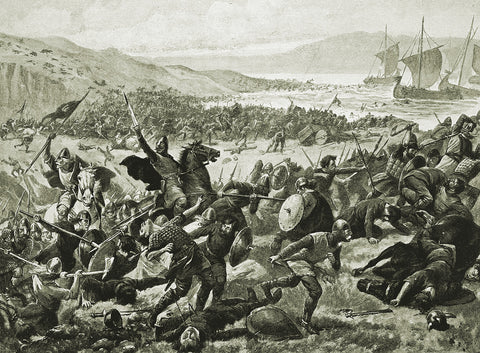
Brunanburh: The Lesser-Known Battle that Unified England
The 1066 Battle of Hastings is the most famous engagement in British medieval history, as it raised the edifice of Norman England from the remains of the Anglo-Saxon state. The latter had been decisively defined, along with the subordinate status of Scotland and Wales, in the long lost to history 937 Battle of Brunanburh.
Britain in the early 10th century was divided and ruled by many kings and lesser factions battling for power. Almost relegated to mythical status, Brunanburh is re-emerging through the groundbreaking research of American historian Michael Livingston, supported by the local Wirral Archaeology group, to verify the battle’s location at Bromborough, north of Chester, where volunteers have unearthed more than 4,000 objects dating from before 950. Referred to in the near contemporary Anglo-Saxon Chronicle as a “never greater slaughter” in the British Isles, this rediscovered battle offers many lessons for the 21st century world.
In Britain’s far north the Celts were divided into the kingdoms of Alba (mainly in Scotland), led by Constantine II, and Strathclyde (southwest Scotland, Cumbria and parts of Wales), ruled by Owain ap Dyfnwal. Northern England was ruled by Viking earls, who also ruled much of Ireland under King Olaf Guthfrithson of Dublin. The Anglo-Saxons controlled most of central and southern England under King Athelstan of Wessex, with several subkingdoms, Mercia in particular, under his control but not yet formally united. Since the late 8th century invading Vikings had encroached southward into Anglo-Saxon territory as the latter consolidated their lands in the south while pushing the Celts farther westward. The situation came to a head in 927 when Athelstan mounted a pre-emptive strike against Jorvik, the Scandinavian kingdom of York. Athelstan’s resulting victory caused great concern to Constantine, who feared the waxing power of the Anglo-Saxons would flood both Celtic and Viking territory. The aging king made frantic diplomatic overtures to his Norse neighbors. This may have included marrying off a daughter to Olaf of Dublin, thus allying with the Norse of both Ireland and Northumbria, as well as with the Celtic Owain of Strathclyde, in an attempt to strike down Athelstan.
In 937 the three leaders assembled an army of about 10,000 men, some marching down the northwest coast of England, others arriving from Ireland and the western and northern Scottish isles. Athelstan gathered his own army, also of some 10,000 men, and the forces met for the battle that determined the development of England for the next millennium.
The fight took place at Brunanburh, probably present-day Bromborough. The Celtic-Norse army likely built timber-fortified trenches, though Athelstan’s men quickly breached them. It remains debatable if it marked the first instance of a British army using cavalry in battle. The Anglo-Saxon victory secured the northern borders of England and contained the Celts to the west. Most important, Athelstan—known since as “the Glorious”—confirmed the unification of Wessex and Mercia, creating the unified kingdom of England that has remained dominant over its historically Celtic neighbors.
Lessons
Good intel is essential. Awareness of the coming attack by the Celtic- Norse alliance enabled Athelstan to adequately prepare his defenses at Brunanburh.
Hit the right target. By sailing around the south coast of England and directly assaulting Athelstan’s power base in Wessex, the Celts and Norse might well have convinced the Celts of south Wales and Cornwall to join the fight.
Consider all proposals. A wedding of Constantine’s daughter and Athelstan might have prevented bloodshed and allowed the unification of Britain as a joint Celtic and Anglo-Saxon state.
this article first appeared in Military History magazine
Facebook @MilitaryHistoryMagazine | Twitter @MilHistoryMag
